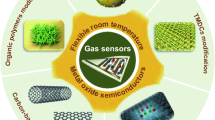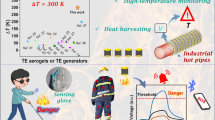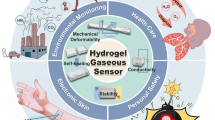Abstract
Through-hole structural humidity sensor was fabricated by radio-frequency magnetron sputtering deposition of gold electrodes on two sides of anodic aluminum oxide (AAO) membranes which were prepared by two-step anodization procedure at 0–5°C and 40 V in 0.5 mol/L oxalic acid electrolyte. The investigation on the impedance at various humid conditions showed a linear relationship between impedance and relative humidity over the range of 12%–97% RH. Other excellent properties such as rapid response and good reproducibility were also obtained.
Similar content being viewed by others
References
Ansbacher F, Jason A C. Effects of water vapour on the electrical properties of anodized aluminium. Nature, 1953, 171: 177–178
Varghese O K, Grimes C A. Metal oxide nanoarchitectures for environmental sensing. J Nanosci Nanotechn, 2003, 3(4): 277–293
Morimoto T, Nagar M, Tokuda F. Relation between the amounts of chemisorbed and physisorbed water on metal oxides. J Phys Chem, 1969, 73: 243–248
Moretti L, De Stefano L, Rendino I. Quantitative analysis of capillary condensation in fractal-like porous silicon nanostructures. J Appl Phys, 2007, 101: 024309
Choi J, Luo Y, Ralf B. Wehrspohn R B, et al. Perfect two-dimensional porous alumina photonic crystals with duplex oxide layers. J Appl Phys, 2003, 94(4): 4757–4762
Jessensky O, Muller F, Gosele U. Self-organized formation of hexagonal pore arrays in anodic alumina. Appl Phys Lett, 1998, 72(10): 1173–1175
Masuda H, Yamada H, Satoh M, et al. Highly ordered nanochannel array architecture in anodic alumina. Appl Phys Lett, 1997, 71(19): 2770–2772
Khanna V K, Nahar R K. Effect of moisture on the dielectric properties of porous alumina films. Sensor Actuat, 1984, 5: 187–188
Traversa E. Ceramic sensors for humidity detection—the state of the art and future development. Sensor Actuat B, 1995, 23: 135–156
Nahar R K, Khanna V K. Ionic doping and inversion of the characteristic of thin film porous Al2O3 humidity sensor. Sensor Actuat B, 1998, 46: 35–41
Nahar R K. Study of the performance degradation of thin film aluminum oxide sensor at high humidity. Sensor Actuat B, 2000, 63: 49–54
Varghese O K, Gong D W, Paulose M, et al. Highly ordered nanoporous alumina films: Effect of pore size and uniformity on sensing performance. J Mater Res, 2002, 17(5): 1162–1171
Zhao X F, Fang Y. Metal nano-hole array copied from AAO template. Acta Phys Sin, 206,55: 3785–3788
Ding G Q, Shen W Z, Zheng M J, et al. Synthesis of ordered large-scale ZnO nanopore arrays. Appl Phys Lett, 2006, 88: 103106
Lazarouk S, Katsouba S, Demianovich A, et al. Reliability of built in aluminum interconnection with low-ε ielectric based on porous anodic alumina. Solid-State Electron, 2000, 44: 815–818
Wang Y C, Leu I C, Hon M H. Dielectric property and structure of anodic alumina template and their effects on the electrophoretic deposition characteristics of ZnO nanowire arrays. J Appl Phys, 2004, 95(3): 1444–1449
Faia P M, Furtado C S, Ferreira A J. AC impedance spectroscopy: A new equivalent circuit for titania thick film humidity sensors. Sensor Actuat B, 2005, 107: 353–359
Author information
Authors and Affiliations
Corresponding author
Additional information
Supported by the research fund of Key Lab of Specially Functional Materials, Ministry of Education, China
About this article
Cite this article
Ling, Z., Chen, S., Wang, J. et al. Fabrication and properties of anodic alumina humidity sensor with through-hole structure. Chin. Sci. Bull. 53, 183–187 (2008). https://doi.org/10.1007/s11434-008-0008-z
Received:
Accepted:
Issue Date:
DOI: https://doi.org/10.1007/s11434-008-0008-z




